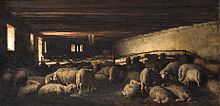Béla Pállik
Béla Pállik (born February 2, 1845 in Großmichel , Kingdom of Hungary , † July 27, 1908 in Budapest ) was a Hungarian animal and portrait painter and opera singer . He was particularly good at depicting domestic sheep .
Life
Pállik showed a talent for drawing already at home and at school. He received an early artistic training in the drawing school of Alajos Landau (1833–1884) and in the studio of the Austrian genre and horse painter Adolf van der Venne in Budapest. He earned his living as an aspiring painter copying old masters in the city's museums. The art collector Count János Waldstein-Wartenberg (1809–1876) soon became aware of him and invited him to his country residence in the castle . There he painted portraits and his first animal pictures. In 1865 he exhibited two pictures at the Society of Fine Arts exhibition in Budapest.
Thanks to a state grant, which his patron was able to obtain from the Hungarian Prime Minister Gyula Andrássy , Pállik moved to Vienna in 1867 and began studying at the Academy of Fine Arts , where Eduard von Engerth taught him. By extending the grant, he was able to enroll in painting at the Royal Academy of Fine Arts in Munich on May 1, 1873 . There he became a student of the painters Wilhelm von Diez and Carl Theodor von Piloty . During this course of study he decided to devote himself to animal painting. In 1873 Pállik was represented at the Vienna World Exhibition .
In 1874 he returned to Budapest, where he established himself as a sought-after portrait and animal painter for the Hungarian aristocracy. In November 1877 even the Austrian Emperor Franz Joseph I , who was then staying at Gödöllő Palace , had himself portrayed by him in a horse hunting costume. Examples of his horse paintings include the portrait of Kincsem , an English thoroughbred mare from the breeding and racing stable of Ernst von Blaskovits who has never been defeated in 54 races. Having made some fortune, Pállik bought an old church in 1880 and converted it into a studio with an apartment.
When an eye disease forced him to stop painting, he began to take singing lessons. On the advice of his family and friends, he sold his studio and apartment in 1883. He traveled to Germany and performed successfully as an opera singer on German stages, including in Berlin , Bremen , Dortmund , Düsseldorf , Cologne and Weimar . He is said to have mastered over thirty roles, especially from operas by Richard Wagner , right from the start. In 1886 he settled in Düsseldorf on Alleestraße . There he also took part in the cultural life of the painters. In 1886, for example, he was involved in an exhibition committee at the Städtische Kunsthalle . From Düsseldorf, where his daughter Margareta Cornelia Helene was born on August 27, 1886, he traveled to his engagements, especially to Nordkirchen Castle in summer , which was then owned by his Hungarian compatriot Miklós Esterházy de Galántha .
After his eye problem subsided, Pállik began painting animals again. He set up a studio in his Düsseldorf apartment. He had sheep brought there to work faithfully. With the help of Nicholas III. Esterházy de Galantha , who promoted him, he was soon successful again as a painter. Around 1888 he moved to Tata , where Miklós Esterházy had a castle theater built on the bank of a lake. There Pállik directed various performances and also appeared in singing roles himself. In addition, he exhibited his paintings internationally, for example at the Salon de Paris in 1890. In the same year he purchased a piece of land in the Budapest artists' colony Epreskerti and built a studio house. Later it became the residence of the painter Károly Kernstok .
Meyers Konversations-Lexikon stated in 1892 that Pállik's “stables with sheep and lambs surpass everything that the sheep painters Jacque , Brendel and Gebler have achieved.”
literature
- Pállik Béla . In: Tamás Szana: Magyar művészek: Műtörténelmi vázlatok képekkel . Hornyánszky V., 1889, p. 192.
- Pallik, Béla . In: Friedrich von Boetticher : painter works of the nineteenth century. Contribution to art history . Volume II / 1, Dresden 1896, p. 212 f.
- Pállik, Béla . In: Emmanuel Bénézit : Dictionnaire critique et documentaire des peintres, sculpteurs, dessinateurs et graveurs de tous les temps et de tous les pays . Volume 10: Mullert – Pinto Pereira . Gründ, Paris 1999, ISBN 2-7000-3010-9 .
Web links
- Bela Pallik , data sheet in the rkd.nl portal( RKD - Nederlands Instituut voor Kunstgeschiedenis )
- Pállik Béla , biography on the epa.oszk.hu portal(Hungarian)
Individual evidence
- ↑ 02890 Bela Pallik , registration of the Academy of Fine Arts Munich
- ^ Bote for Tyrol and Vorarlberg , edition of December 1, 1877, p. 2166 ( Google Books )
- ↑ Desző Dercsényi, Balász Dercsényi: Art guide through Hungary . Corvina Verlag, Budapest 1974, p. 142
- ^ Museum Kunstpalast : Artists from the Düsseldorf School of Painting (selection, as of November 2016, PDF )
- ^ Theodor Levin : Directory of the pictures by older masters exhibited in the Kunsthalle zu Düsseldorf . Bagel, Düsseldorf 1886, preface ( digitized version )
- ^ Civil status of the Lord Mayor of Düsseldorf . In: Düsseldorfer Volksblatt , edition of September 7th, 1886 ( digitized version )
- ^ Herrmann Julius Meyer (Ed.): Meyers Konversations-Lexikon . Bibliographisches Institut, Volume 19, Berlin 1892, p. 560
| personal data | |
|---|---|
| SURNAME | Pállik, Béla |
| BRIEF DESCRIPTION | Hungarian animal and portrait painter as well as opera singer |
| DATE OF BIRTH | February 2, 1845 |
| PLACE OF BIRTH | Großmichel , Kingdom of Hungary |
| DATE OF DEATH | July 27, 1908 |
| Place of death | Budapest |



